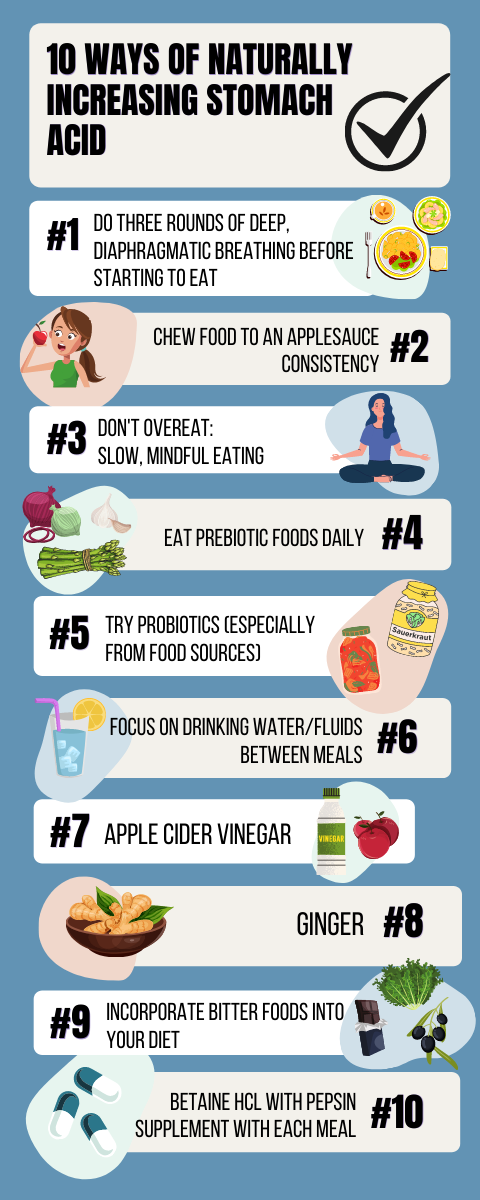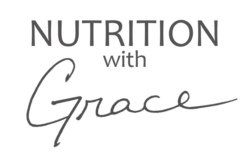table of contents
How many of you have been told that you’re experiencing reflux or indigestion because you have too much acid in your stomach? Then you’re told that you need take Prilosec, Pepcid AC, or any other acid reducing drug to make yourself feel better.
What if I told you that your heartburn (and even your stomach bloating after eating and constipation) is more likely to be caused by LOW stomach acid?
I’m going to let that sit for a second……….did I just blow your mind?
The truth is, our stomachs are supposed to be acidic and it is actually incredibly rare for your stomach to have too much acid.
Stick with me because in this article we will go over:
- the role of stomach acid in normal digestion
- what causes low stomach acid and the consequences of it
- how to test if your stomach acid is low
And finally…
- 10 easy ways for naturally increasing stomach acid
Let’s dive in!
Stomach Acid and Digestion
Digestion: Step 1
Digestion actually starts before you even put any food into your mouth. Studies have shown that even the smell of food (especially when you’re already hungry) is enough to stimulate your salivary glands to start pushing out saliva. (1)
We’ve all experienced our mouth start to water when we smell a fresh batch of French fries or garlic and onions sautéing on the stove, right? Well, this is your digestive tract telling your brain that it’s time to get ready to digest some food.
Digestion: Step 2
Next, you take your first bite of food and start to chew. It may seem trivial, but this is a crucial step in the digestive process. This is where the food will start being broken down so it can be safely swallowed and enter the stomach.
Enzymes in your saliva (i.e. amylase) will also start breaking down any starches you are currently eating. It also sends signals to the stomach to get ready to start secreting stomach acid (i.e. hydrochloric acid – HCL). (2)
This is often a step I struggle with because I was raised in a household of very fast eaters. Sometimes I can’t even remember what the food tastes like because I’m so focused on getting it down without stopping. DO NOT follow my example.
It’s important to take your time during this step because it’s going to set the stage for the rest of the digestive process. In fact, it’s recommended that you chew your food until it reaches an applesauce-like consistency before swallowing.
Digestion: Step 3:
Now that our food is nice and chewed up and has passed through your esophagus, it’s time for the stomach to do its job.
Your stomach is responsible for three main things (2, 3, 4):
- Starting the breakdown of protein.
- Churning the partially digested food into a consistency that can easily enter the small intestine.
- Acting as the main line of defense for defeating harmful pathogens.
None of these actions can occur without stomach acid. Why, you ask?
For starters, HCL is in charge of initiating protein digestion and getting it ready for the enzyme, pepsin, to continue the process. Second, pepsin can only be activated in an acidic environment, and third, very few bacteria can survive at a pH of 2 , which is equivalent to lemon juice and the optimal pH for your stomach. (2)
Once the stomach contents are at the perfect consistency, the stomach is ready to pass it into the small intestine through a process called gastric emptying. This process is influenced by a variety of factors, including the macronutrient makeup of your meal (i.e. high-fat meals slow this down) and the amount of food you ate. (2)
The final key role of stomach acid happens when the partially digested food mixed with stomach juices (including HCL) hits the top of the small intestine, called the duodenum. The HCL is what signals the duodenum to start secreting other digestive enzymes that will become essential later in the process. (2)
As you can see, all of the above mentioned process can not happen efficiently if there is not enough acid in your stomach. Now that we’ve taken a deep dive into the role stomach acid plays in normal, healthy digestion, let’s talk about what happens when things are out of balance.
Signs Your Stomach Acid is Out of Balance
The challenging thing about determining whether you have low or high stomach acid is that they have very similar symptoms. Unfortunately, the go-to treatment for these symptoms (at least in Western medicine) is acid-reducing supplements or medications (i.e. PPIs – proton pump inhibitors), such as Prilosec or Prevacid.
If you are actually experiencing low stomach acid, this treatment plan is going to do WAY more harm than good. I recommend ruling out low stomach acid before trying any sort of PPI or antacid.
Here are the most common symptoms to look out for:
- Gas/burping after eating
- Bloating
- Food feeling like it’s sitting heavy in your stomach (especially high protein meals)
- Cramping
- Heartburn
- Frequent constipation and/or diarrhea
- Undigested food in stools
- Acne or other skin issues
- Recurring SIBO or other infections
- Nausea after taking supplements
Causes of Low Stomach Acid
There are a variety of potential root causes to low stomach acid. Some of these include:
- Eating too quickly (i.e. not chewing enough)
- Chronic stress/eating in a stressed state
- Nutrient deficiency: Zinc, iron and vitamin B12 in particular. (5)
- Age (> age 60) (6, 7, 8, 9)
- Antacids/prescription drugs (5, 10, 11)
- Infection (i.e. H. pylori)
Consequences of Low Stomach Acid
For something that seems so small, having low stomach acid can actually have an array of consequences to your overall health. Some of these consequences include:
- Food not being digested /slow digestion
- Nutrient deficiencies (iron, B12, folic acid, zinc, calcium) (6, 10, 12, 13, 14, 15)
- Indigestion/Heartburn
- GERD
- Nausea after eating
- Skin issues
- Cancer (16)
- Rheumatoid arthritis (17, 18)
- GI infections (19, 20)
- Osteoporosis (21)
- Food allergies or intolerances (22)
- Leaky gut
- IBS
- Chronic/recurring to SIBO (23)
How to Test if You Need to Increase Your Stomach Acid
Baking Soda Test: Drink 1/4 tsp of baking soda in 4oz of water on an empty stomach. If you do not burp within 5 minutes, you may have low stomach acid.
HCL Supplement Test: Before eating your largest, protein-containing meal of the day, take 1 capsule of HCL-betaine (350-750mg) and observe what it feels like. If there is a burning sensation, your stomach acid is fine. But if you don’t feel anything, take 2 capsules with the largest, protein-containing meal the next day and observe what happens. If you still don’t feel anything, follow the same process the following day with 3 capsules. If you reach 2-3 capsules without feeling a burning sensation in your stomach, you likely have low stomach acid. (24)
Now, what you’ve all been waiting for…
10 Ways for Naturally Increasing Stomach Acid
- Do three rounds of deep, diaphragmatic breathing before starting to eat. This will help ground you and prepare your body to receive the food you’re about to eat. Like I mentioned in the first section, proper digestion starts before you even put food in your mouth. Putting yourself in a calm, de-stressed state will allow your body to focus on digesting.
- Chew food to an applesauce consistency. Slowing down and taking the time to chew your food until it reaches an applesauce-like consistency will give your brain time to signal the release of digestive hormones, enzymes, and HCL. It will also decrease the amount of work the rest of GI tract has to put in.
- Don’t overeat – slow, mindful eating. Consciously taking the time to truly enjoy what you’re eating by slowing down and being mindful of the process will allow you to pay better attention to your hunger cues and feelings of fullness. Overfilling your stomach will lead to slowed digestion and make it harder for the HCL to do its job. It will also increase symptoms such has heartburn, indigestion, and bloating.
- Eat prebiotic foods daily. Prebiotics are important food sources for the “good gut bugs” that are present in small and large intestines. They help promote good digestion overall and have been shown to increase mineral absorption, which is especially important in individuals with low stomach acid. Foods that are good sources of prebiotics include green bananas, garlic, onions, leeks, asparagus, barley, and oats. (25)
- Try probiotics (especially from food sources). Probiotics have also been shown to improve absorption and retention of minerals, such as calcium, magnesium, phosphorous, iron, and zinc. They have also shown signs of reducing the effects of low stomach acid that results from certain bacterial stomach infections. Good probiotic foods include plain, non-sweetened kefir, sauerkraut, and kimchi. (26, 27)
- Focus on drinking water/fluids between meals. Drinking a lot of water during meals actually dilutes the stomach juices, which leads to the acid not being as potent. The end result is an increase in pH of the stomach. This doesn’t mean you can’t drink anything while you’re eating, but it should help to focus on getting most of your water between meals.
- Apple cider vinegar. About 10 minutes before each meal, drink 2 tsp mixed in 75mL of water. If low stomach acid is your issue, you should start to feel relief in about 3 days. You want to find a brand that does not filter out the mother, which is a pulp like substance, because that is where you’re going to get most of the benefits from. The brand I recommend is Bragg Apple Cider Vinegar.
- Ginger. This is more to soothe indigestion, bloating, gas/burping, and other uncomfortable symptoms of low stomach acid. It has also been shown to speed up the rate of gastric emptying, which will help relieve the feelings of early fulness. Take this with water, between meals and not right before bed or before laying down. (28, 29)
- Incorporate bitter foods into your diet. These include foods like very dark chocolate, dandelion greens, endive, olives, and wormwood. When bitter foods hit the tongue, they actually trigger the release of more saliva and stomach acid. In fact, we have bitter taste receptors throughout our digestive tracts and every time these receptors are stimulated, they signal the release of another digestive secretion. (30)
- Betaine HCL with Pepsin supplement with each meal. Once you establish how many betaine HCL supplements you need from the test, take that amount 5-7 minutes before every meal that is at least 500 calories. If you start to experience discomfort, tingling, burning, etc. you can decrease the dose. (24, 31, 32)
**Note: This tip should only be followed if you are working with a healthcare provider and have completed the HCL Supplement Test to determine need and dose. Keep in mind that this is only a temporary fix and should be used alongside the other lifestyle changes for long-term, sustained improvement.

Final Thoughts
All in all, low stomach acid is actually more common than high stomach acid, but it can be challenging to know the difference because they present with very similar symptoms. The number one indicator that increasing your stomach acid will be beneficial is if a high protein meal feels like it sits heavy in your stomach. If you suspect this is your issue, take one of the at-home stomach acid tests and consult a healthcare professional that specializes in digestion and the GI tract (like a dietitian!).
want this article?
download now, reference later!
jumpstart your journey to better gut health
Print Resources:
2. Gropper SS, Smith JL, Groff JL. Advanced Nutrition and Human Metabolism. 5th ed. Belmont, CA: Wadsworth Cengage Learning; 2009: 35-56.






